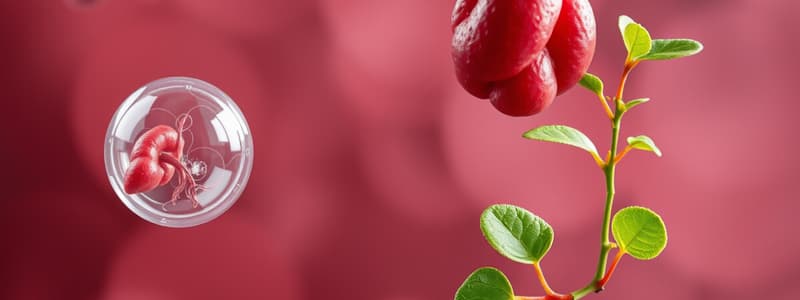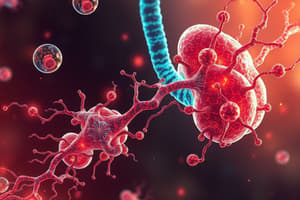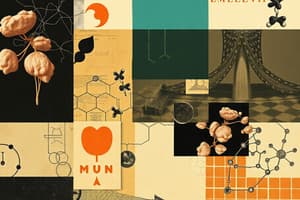Podcast
Questions and Answers
What role does oxygen play in cellular respiration?
What role does oxygen play in cellular respiration?
Oxygen is the final electron acceptor.
Why is more ATP made per molecule of NADH than per molecule of FADH2?
Why is more ATP made per molecule of NADH than per molecule of FADH2?
Because fewer protons are pumped across the inner mitochondrial membrane with FADH2.
If gramicidin is added to an actively respiring muscle cell, how would it affect the rates of electron transport, proton pumping, and ATP synthesis?
If gramicidin is added to an actively respiring muscle cell, how would it affect the rates of electron transport, proton pumping, and ATP synthesis?
- Electron transport rate remains the same (correct)
- Proton pumping rate remains the same (correct)
- ATP synthesis decreases (correct)
- All of the above
What does fermentation produce in muscle cells?
What does fermentation produce in muscle cells?
In fermentation, ____________ is reduced and ______________ is oxidized.
In fermentation, ____________ is reduced and ______________ is oxidized.
What is the main coupling among the stages of cellular respiration?
What is the main coupling among the stages of cellular respiration?
What stops the conversion of pyruvate to acetyl CoA under anaerobic conditions?
What stops the conversion of pyruvate to acetyl CoA under anaerobic conditions?
How is the rate of cellular respiration regulated?
How is the rate of cellular respiration regulated?
What happens to the cell's rate of glucose utilization under anaerobic conditions?
What happens to the cell's rate of glucose utilization under anaerobic conditions?
During the electron transport, energy from ______________ is used to pump hydrogen ions into the _________________.
During the electron transport, energy from ______________ is used to pump hydrogen ions into the _________________.
What is Structure A in relation to ATP production?
What is Structure A in relation to ATP production?
For each glucose that enters glycolysis, ________ acetyl CoA enters the citric acid cycle.
For each glucose that enters glycolysis, ________ acetyl CoA enters the citric acid cycle.
Which molecule is metabolized in a cell to produce energy 'currency' in the form of ATP?
Which molecule is metabolized in a cell to produce energy 'currency' in the form of ATP?
The potential energy in an ATP molecule is derived mainly from its three phosphate groups.
The potential energy in an ATP molecule is derived mainly from its three phosphate groups.
In the citric acid cycle, ATP molecules are produced by...
In the citric acid cycle, ATP molecules are produced by...
Which of these is NOT a product of the citric acid cycle?
Which of these is NOT a product of the citric acid cycle?
What is the product of pyruvate fermentation in human muscle?
What is the product of pyruvate fermentation in human muscle?
What is the product of pyruvate fermentation in yeast and bacteria?
What is the product of pyruvate fermentation in yeast and bacteria?
What is the product of pyruvate metabolism by aerobic oxidation?
What is the product of pyruvate metabolism by aerobic oxidation?
What are the reactants in anaerobic reduction of pyruvate during lactic acid fermentation?
What are the reactants in anaerobic reduction of pyruvate during lactic acid fermentation?
What are the products in anaerobic reduction of pyruvate during lactic acid fermentation?
What are the products in anaerobic reduction of pyruvate during lactic acid fermentation?
What process occurs in structure H?
What process occurs in structure H?
What molecules belong in spaces A and B?
What molecules belong in spaces A and B?
What organelle is indicated by the letter C?
What organelle is indicated by the letter C?
What molecules belong in spaces E and F?
What molecules belong in spaces E and F?
What process occurs in Box A?
What process occurs in Box A?
What process occurs within Box B?
What process occurs within Box B?
What molecule is indicated by the letter D?
What molecule is indicated by the letter D?
When a glucose molecule loses a hydrogen atom in an oxidation-reduction reaction, the glucose molecule is __________.
When a glucose molecule loses a hydrogen atom in an oxidation-reduction reaction, the glucose molecule is __________.
Which statement best describes what happens to a molecule of NAD+ when it gains a hydrogen atom?
Which statement best describes what happens to a molecule of NAD+ when it gains a hydrogen atom?
How many NADH are produced by glycolysis?
How many NADH are produced by glycolysis?
In glycolysis, ATP molecules are produced by...
In glycolysis, ATP molecules are produced by...
Which of these is NOT a product of glycolysis?
Which of these is NOT a product of glycolysis?
In glycolysis, what starts the process of glucose oxidation?
In glycolysis, what starts the process of glucose oxidation?
In glycolysis, there is a net gain of ________ ATP.
In glycolysis, there is a net gain of ________ ATP.
When a compound donates (loses) electrons, that compound becomes __________.
When a compound donates (loses) electrons, that compound becomes __________.
When a compound accepts (gains) electrons, that compound becomes __________.
When a compound accepts (gains) electrons, that compound becomes __________.
In glycolysis, the carbon-containing compound that functions as the electron donor is __________.
In glycolysis, the carbon-containing compound that functions as the electron donor is __________.
Once the electron donor in glycolysis gives up its electrons, it is oxidized to a compound called __________.
Once the electron donor in glycolysis gives up its electrons, it is oxidized to a compound called __________.
____________ is the compound that functions as the electron acceptor in glycolysis.
____________ is the compound that functions as the electron acceptor in glycolysis.
The reduced form of the electron acceptor in glycolysis is __________.
The reduced form of the electron acceptor in glycolysis is __________.
Among the products of glycolysis, which compounds contain energy that can be used by other biological reactions?
Among the products of glycolysis, which compounds contain energy that can be used by other biological reactions?
What enters the citric acid cycle?
What enters the citric acid cycle?
In the citric acid cycle, ATP molecules are produced by...
In the citric acid cycle, ATP molecules are produced by...
Which of these is NOT a product of the citric acid cycle?
Which of these is NOT a product of the citric acid cycle?
In the citric acid cycle, pyruvate is oxidized to __________.
In the citric acid cycle, pyruvate is oxidized to __________.
In the citric acid cycle, NAD+ is reduced to __________.
In the citric acid cycle, NAD+ is reduced to __________.
In the citric acid cycle, FAD is reduced to ______________.
In the citric acid cycle, FAD is reduced to ______________.
Which molecule is metabolized in a cell to produce energy 'currency' in the form of ATP?
Which molecule is metabolized in a cell to produce energy 'currency' in the form of ATP?
True or false? The potential energy in an ATP molecule is derived mainly from its three phosphate groups.
True or false? The potential energy in an ATP molecule is derived mainly from its three phosphate groups.
What process is not a part of the cellular respiration pathway that produces large amounts of ATP in a cell?
What process is not a part of the cellular respiration pathway that produces large amounts of ATP in a cell?
Which step of the cellular respiration pathway can take place in the absence of oxygen?
Which step of the cellular respiration pathway can take place in the absence of oxygen?
Into which molecule are all the carbon atoms in glucose ultimately incorporated during cellular respiration?
Into which molecule are all the carbon atoms in glucose ultimately incorporated during cellular respiration?
Which of the following statements about the electron transport chain is true?
Which of the following statements about the electron transport chain is true?
Which stage of glucose metabolism produces the most ATP?
Which stage of glucose metabolism produces the most ATP?
True or false? The reactions that generate the largest amounts of ATP during cellular respiration take place in the mitochondria.
True or false? The reactions that generate the largest amounts of ATP during cellular respiration take place in the mitochondria.
For each glucose that enters glycolysis, ________ acetyl CoA enter the citric acid cycle.
For each glucose that enters glycolysis, ________ acetyl CoA enter the citric acid cycle.
For each glucose that enters glycolysis, _______ NADH + H+ are produced by the citric acid cycle.
For each glucose that enters glycolysis, _______ NADH + H+ are produced by the citric acid cycle.
In cellular respiration, the most ATP molecules are produced by...
In cellular respiration, the most ATP molecules are produced by...
The final electron acceptor of cellular respiration is _____________.
The final electron acceptor of cellular respiration is _____________.
During electron transport, energy from ______________ is used to pump hydrogen ions into the _________________.
During electron transport, energy from ______________ is used to pump hydrogen ions into the _________________.
Structure A is _____________.
Structure A is _____________.
The proximate source of energy for oxidative phosphorylation is...
The proximate source of energy for oxidative phosphorylation is...
Net inputs of glycolysis are...
Net inputs of glycolysis are...
Net outputs of glycolysis are...
Net outputs of glycolysis are...
Inputs that are not part of glycolysis are...
Inputs that are not part of glycolysis are...
Net input of acetyl CoA includes...
Net input of acetyl CoA includes...
Net output of acetyl CoA includes...
Net output of acetyl CoA includes...
Not an input or output of acetyl CoA includes...
Not an input or output of acetyl CoA includes...
Net input of citric acid cycle includes...
Net input of citric acid cycle includes...
Net output of the citric acid cycle includes...
Net output of the citric acid cycle includes...
Not an input or output of the citric acid cycle includes...
Not an input or output of the citric acid cycle includes...
Net input of oxidative phosphorylation includes...
Net input of oxidative phosphorylation includes...
Net output of oxidative phosphorylation includes...
Net output of oxidative phosphorylation includes...
Not an input or output of oxidative phosphorylation includes...
Not an input or output of oxidative phosphorylation includes...
Glycolysis occurs in the __________.
Glycolysis occurs in the __________.
Acetyl CoA formation occurs in the __________.
Acetyl CoA formation occurs in the __________.
Citric Acid Cycle occurs in the __________.
Citric Acid Cycle occurs in the __________.
Oxidative Phosphorylation occurs in the __________.
Oxidative Phosphorylation occurs in the __________.
In mitochondrial electron transport, what is the direct role of O2?
In mitochondrial electron transport, what is the direct role of O2?
How would anaerobic conditions (when no O2 is present) affect the rate of electron transport and ATP production during oxidative phosphorylation?
How would anaerobic conditions (when no O2 is present) affect the rate of electron transport and ATP production during oxidative phosphorylation?
Flashcards are hidden until you start studying
Study Notes
Pyruvate Fermentation Products
- Pyruvate fermentation in human muscle produces lactate.
- In yeast and bacteria, pyruvate fermentation results in ethanol.
Pyruvate Metabolism
- Pyruvate is converted to acetyl CoA during aerobic oxidation.
Anaerobic Reduction of Pyruvate
- Reactants for lactic acid fermentation: NADH and pyruvate.
- Products for lactic acid fermentation: lactate and NAD+.
Photosynthesis and Cellular Respiration
- Photosynthesis occurs within specific structures (labeled H).
- Molecules in spaces A and B include glucose and oxygen, produced by photosynthesis.
- Mitochondria (indicated by letter C) are the cellular respiration sites.
- Carbon dioxide and water are by-products of cellular respiration, found in spaces E and F.
Glycolysis Overview
- Glycolysis takes place in the cytosol and converts glucose to 2 pyruvates.
- ATP is produced through substrate-level phosphorylation during glycolysis.
- Glycolysis yields a net gain of 2 ATP and generates 2 NADH.
Importance of NAD+
- Upon gaining a hydrogen atom, NAD+ is reduced to NADH.
- The electron donor in glycolysis is glucose, which is oxidized to pyruvate.
Citric Acid Cycle Insights
- Acetyl CoA enters the citric acid cycle, where it is oxidized to CO2.
- The cycle produces ATP, NADH, and FADH2, but not acetyl CoA.
- Substrate-level phosphorylation in the citric acid cycle also generates ATP.
Oxidative Phosphorylation
- The most ATP (about 26 molecules) is produced in the electron transport chain and chemiosmosis.
- Oxygen serves as the final electron acceptor, forming water when combined with electrons and hydrogen.
- NADH and FADH2 donate electrons to the electron transport chain, creating a proton gradient used for ATP synthesis.
Role of Cellular Respiration Components
- Glycolysis and citric acid cycle produce intermediates for further energy extraction in oxidative phosphorylation.
- The proton gradient generated by the electron transport chain drives ATP synthase to phosphorylate ADP into ATP.
Mitochondrial Processes
- Glycolysis occurs in the cytosol, while acetyl CoA formation and the citric acid cycle occur in the mitochondrial matrix.
- Oxidative phosphorylation takes place in the inner mitochondrial membrane, where electron transport and ATP synthesis occur.
- A decrease or absence of oxygen halts electron transport and ATP production.
ATP Yield Sources
- Each glucose molecule produces two acetyl CoA, leading to 6 NADH from the citric acid cycle.
- Oxidative phosphorylation is the main contributor to ATP production, requiring NAD+, ADP, and O2.
Importance of NADH vs. FADH2
- More ATP is synthesized from NADH compared to FADH2 due to the point of entry in the electron transport chain; NADH enters at Complex I while FADH2 enters at Complex II, resulting in fewer protons being pumped.
Effects of Gramicidin
- If gramicidin is added, it affects proton permeability, likely disrupting proton pumping and ATP synthesis in oxidative phosphorylation, without influencing NADH and FADH2 production from earlier processes.### Proton Gradient and ATP Synthesis
- Proton pumping rate, electron transport rate, and oxygen uptake remain constant with gramicidin's effect.
- Gramicidin increases membrane permeability, disrupting the proton gradient and halting ATP synthesis.
- Leakiness of the membrane does not affect the efficiency of electron transport.
Fermentation in Muscle Cells
- Fermentation produces lactate and NAD+ in muscle cells.
- Pyruvate is reduced to lactate or ethanol, while NADH is oxidized back to NAD+ during fermentation.
Coupling in Cellular Respiration
- Cellular respiration stages are interconnected; outputs of one stage serve as inputs for others.
- NAD+ and NADH play crucial roles in this coupling, with NAD+ accepting electrons during glucose oxidation.
- NADH generated in earlier stages is oxidized during oxidative phosphorylation to regenerate NAD+.
Anaerobic Conditions and Pyruvate Conversion
- Lack of oxygen halts the conversion of pyruvate to acetyl CoA due to stopped electron transport.
- Without NAD+ regeneration, essential for glycolysis, the oxidative phosphorylation process ceases.
Regulation of Cellular Respiration
- ATP acts as a feedback inhibitor for phosphofructokinase (PFK), impacting glycolysis and ATP production.
- Increased ATP demand leads to initial drops in ATP levels, decreasing PFK inhibition, thus enhancing glucose utilization and ATP production.
Importance of Glycolysis and Fermentation
- Under anaerobic conditions, glycolysis persists while oxidative phosphorylation halts, relying on fermentation.
- Fermentation leads to a net gain of 2 ATP per glucose; to meet ATP needs under anaerobic conditions, glucose utilization must increase significantly.
Electron Transport Chain Function
- Energy from NADH and FADH2 is harnessed to pump hydrogen ions into the intermembrane space during electron transport.
- This process contributes to establishing a proton gradient necessary for ATP synthesis.
ATP Synthase Role
- ATP synthase phosphorylates ADP to produce ATP, functioning as the primary enzyme in ATP generation.
Acetyl CoA Production
- Each glucose molecule entering glycolysis results in the formation of two acetyl CoA for the citric acid cycle.
Energy Currency in Cells
- Glucose is primarily metabolized for energy in the form of ATP within cells.
Potential Energy in ATP
- The energy potential of ATP molecules originates from their three phosphate groups, facilitating cellular energy transfer.
ATP Production in the Citric Acid Cycle
- ATP molecules are generated through substrate-level phosphorylation when a phosphate group is transferred from GTP to ADP during the citric acid cycle.
Citric Acid Cycle Products
- The citric acid cycle yields products such as ATP, FADH2, and NADH, but acetyl CoA is not a product of this cycle.
Studying That Suits You
Use AI to generate personalized quizzes and flashcards to suit your learning preferences.




